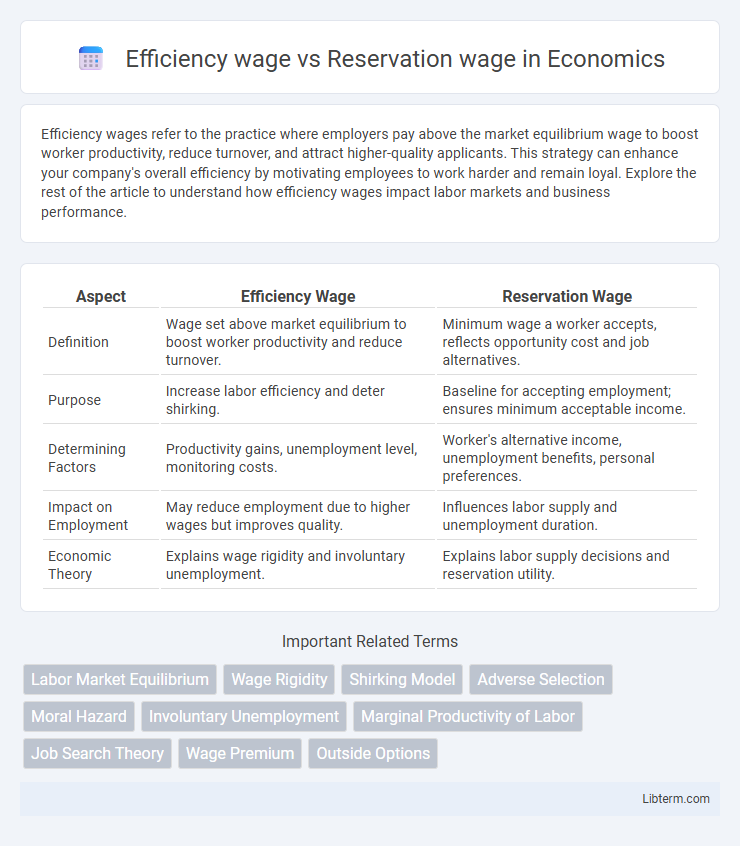Efficiency wages refer to the practice where employers pay above the market equilibrium wage to boost worker productivity, reduce turnover, and attract higher-quality applicants. This strategy can enhance your company's overall efficiency by motivating employees to work harder and remain loyal. Explore the rest of the article to understand how efficiency wages impact labor markets and business performance.
Table of Comparison
| Aspect | Efficiency Wage | Reservation Wage |
|---|---|---|
| Definition | Wage set above market equilibrium to boost worker productivity and reduce turnover. | Minimum wage a worker accepts, reflects opportunity cost and job alternatives. |
| Purpose | Increase labor efficiency and deter shirking. | Baseline for accepting employment; ensures minimum acceptable income. |
| Determining Factors | Productivity gains, unemployment level, monitoring costs. | Worker's alternative income, unemployment benefits, personal preferences. |
| Impact on Employment | May reduce employment due to higher wages but improves quality. | Influences labor supply and unemployment duration. |
| Economic Theory | Explains wage rigidity and involuntary unemployment. | Explains labor supply decisions and reservation utility. |
Understanding Efficiency Wage Theory
Efficiency wage theory posits that employers pay wages above the market-clearing level to boost worker productivity, reduce turnover, and attract higher-quality employees. Unlike the reservation wage, which is the minimum wage a worker is willing to accept to take a job, efficiency wages create incentives for employees to perform better and discourage shirking. This theory explains wage rigidity and unemployment as employers maintain higher wages to maximize efficiency rather than simply to meet workers' minimum acceptable pay.
Defining Reservation Wage
Reservation wage is the minimum wage level at which a worker is willing to accept a particular job, reflecting their alternative options and opportunity costs in the labor market. It represents the threshold below which employment is not considered worthwhile, influencing labor supply decisions and job acceptance rates. Efficiency wages are typically set above the reservation wage to enhance productivity and reduce turnover, contrasting with the reservation wage's role in setting the baseline for employment acceptance.
Key Differences Between Efficiency and Reservation Wages
Efficiency wages refer to the above-market wages paid by employers to increase worker productivity, reduce turnover, and attract higher-quality employees. Reservation wages represent the minimum wage level at which a worker is willing to accept a job, reflecting their opportunity cost of labor and alternative income sources. Key differences include that efficiency wages are employer-driven incentives to boost work effort, while reservation wages are worker-driven thresholds for employment acceptance.
Factors Influencing Efficiency Wages
Efficiency wages are influenced by factors such as worker productivity, labor market competition, and the cost of employee turnover, which motivate firms to pay above the market-clearing wage. These wages aim to increase effort, reduce shirking, and attract higher-quality candidates, enhancing overall firm performance. In contrast, reservation wage reflects the minimum acceptable wage for a worker to accept a job, shaped primarily by individual opportunity costs and alternative employment options.
Determinants of Reservation Wages
Reservation wages are primarily determined by factors such as individual skills, alternative employment opportunities, unemployment benefits, and the cost of job search. Higher education levels and specialized skills typically increase reservation wages by enhancing a worker's market value. Financial necessities, prevailing labor market conditions, and personal preferences also significantly influence the minimum acceptable wage a worker demands before accepting a job offer.
Impact on Labor Market Dynamics
Efficiency wages increase worker productivity by paying above-market salaries, reducing turnover and absenteeism, thereby tightening labor market supply and potentially leading to involuntary unemployment. Reservation wages represent the minimum compensation a worker is willing to accept, influencing job search intensity and unemployment duration by setting a floor on acceptable job offers. The interaction between efficiency wages and reservation wages shapes labor market dynamics by affecting wage rigidity, labor supply elasticity, and equilibrium employment levels.
Employer Strategies: Choosing Wage Policies
Employers adopting efficiency wage strategies set wages above the market equilibrium to boost worker productivity, reduce turnover, and attract higher-quality talent. Reservation wage policies focus on offering wages that meet or exceed the minimum acceptable payoff for employees to accept a job, ensuring baseline motivation and labor supply. Balancing these wage policies enables employers to optimize labor costs while maximizing workforce efficiency and retention.
Effects on Employee Motivation and Productivity
Efficiency wage theory posits that paying employees above the market-clearing wage increases motivation and productivity by reducing turnover and encouraging effort, as workers strive to avoid losing a valuable higher-paying job. Reservation wage represents the minimum acceptable wage that workers require to engage in a job, influencing their willingness to exert effort and stay employed. When wages exceed the reservation wage, employees are more motivated, leading to enhanced productivity and a stronger commitment to organizational goals.
Policy Implications for Wage Setting
Efficiency wage theory suggests that paying workers above their reservation wage increases productivity, reduces turnover, and discourages shirking, prompting policymakers to consider minimum wages or wage floors to boost labor market efficiency. In contrast, reservation wage reflects the lowest wage a worker accepts, influencing unemployment rates and necessitating policies that balance adequate income support with incentives to work. Wage-setting policies must integrate these concepts to optimize employment levels while maintaining incentives for productivity and labor participation.
Real-World Examples and Case Studies
Efficiency wage theory explains why firms pay above-market wages to boost productivity, as seen in companies like Costco and Starbucks, which maintain higher pay to reduce turnover and enhance worker effort. Reservation wage represents the minimum wage a worker accepts, influenced by factors such as unemployment benefits or alternative job opportunities, exemplified in studies of labor markets in Scandinavia where generous welfare policies raise reservation wages. Case studies from manufacturing sectors in China highlight efficiency wages improving output, while reservation wage levels adjust according to regional economic conditions and social safety nets.
Efficiency wage Infographic

 libterm.com
libterm.com